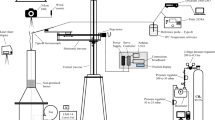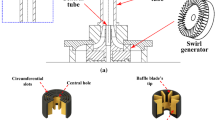Abstract
In this study, the improvement of liftoff height of bluffbody-stabilized, partially premixed methane flames and the change of flow field in the recirculation zone of bluffbodies, of variously modified base geometries, are investigated in a high temperature (~1,315 K) vitiated flow. The basic geometry of the bluffbody consists of a two-dimensional rectangular body with a rounded nose with fuel jets being discharged from the body at several locations upstream of the base. Flame liftoff height measurements are characterized by CH chemiluminescence, while the three-dimensional flow field is determined using stereo particle image velocimetry (PIV). The lowest liftoff height is observed when the geometric modifications from the original rectangular bluffbody base are carried out such that the base has three-dimensional local cavities together with two-dimensionally modified geometries. PIV measurements show that the improvement of liftoff height is primarily attributed to an intense recirculation induced by multi-dimensional vortex structures in the presence of the two- and three-dimensionally modified base.


















Similar content being viewed by others
References
Ballal DR, Lefebvre AH (1979) Weak extinction limits of turbulent flowing mixtures. J Eng Gas Turbine Power 101:343–348
Basu P, Kefa C, Jestin L (2000) Boilers and burners: design and theory. Springer, New York
Cabra R (2003) Turbulent jet flames into a vitiated coflow. Dissertation, University of California
Esquiva-Dano I, Nguyen HT, Escudie D (2001) Influence of a bluff-body’s shape on the stabilization regime of non-premixed flames. Combust Flame 127:2167–2180
Flack RD (2005) Fundamentals of jet propulsion with applications. Cambridge University Press, New York
Khosla S, Leach TT, Smith CE (2007) Flame stabilization and role of von karman vortex shedding behind bluff body flameholders. In: 43rd AIAA/ASME/SAE/ASEE joint propulsion conference and exhibit, Cincinnati, OH, USA
King CR (1957) Experimental investigation of effects of combustion chamber length and inlet total temperature, total pressure, and velocity on afterburner performance. National Advisory Committee on Aeronautics NACA RM E57C07
Kurimoto N, Suzuki Y, Kasagi N (2004) Coaxial jet control for lifted flame stabilization with arrayed miniature actuators. In: 12th International symposium on applications of laser techniques, Lisbon, Portugal
Longwell JP, Chenevey JE, Clark WW, Frost EE (1948) Flame stabilization by baffles in a high velocity gas stream. Proc Comb Inst 3:40–44
Lovett JA, Brogan TP, Philippona DS, Keil BV, Thompson TV (2004) Development needs for advanced afterburner designs. In: 40th AIAA/ASME/SAE/ASEE joint propulsion conference and exhibit, Fort Lauderdale, FL, USA
Mattingly JD, Heiser WH, Pratt DT (2002) Aircraft engine design. AIAA, Reston, VA
Mullinger P, Jenkins B (2008) Industrial and Process Furnaces: principles, design and operation. Butterworth-Heinemann, Oxford
Park H, Lee D, Jeon W, Hahn S, Kim J, Kim J, Choi J, Choi H (2006) Drag reduction in flow over a two-dimensional bluff body with a blunt trailing edge using a new passive device. J Fluid Mech 563:389–414
Paschereit CO, Flohr P, Gutmark EJ (2006) Combustion control by vortex breakdown stabilization. J Turbo Mach 128:679–688
Sanquer S, Bruel P, Deshaies B (1998) Some specific characteristics of turbulence in the reactive wakes of bluff bodies. AIAA 6:994–1001
Shanbhogue SJ, Husain S, Lieuwen T (2009) Lean blowoff of bluff body stabilized flames: scaling and dynamics. Prog Energy Combust Sci 35:98–120
Smith SH, Mungal MG (1998) Mixing, structure and scaling of the jet in crossflow. J Fluid Mech 357:83–122
Sovran G, Morel T, Mason WT (1978) Aerodynamic drag mechanisms of bluff bodies and road vehicles. Plenum Press, New York
Zukoski EE (1954) Flame stabilization on bluff bodies at low and intermediate Reynolds numbers. PhD Thesis, California Institute of Technology
Acknowledgments
This work is sponsored by the AFOSR/STTR Program with Cascade Technologies Inc.—Stability Models for Augmentor Design Tools and Technology Assessment, with Julian Tishkoff as the Technical Monitor. The authors would like to thank Prof. R. Dibble at U.C. Berkeley for providing the premixed burner and Prof. Heinz Pitsch for useful discussion.
Author information
Authors and Affiliations
Corresponding author
Rights and permissions
About this article
Cite this article
Kim, W., Im, Sk., Do, H. et al. Flame liftoff height dependence on geometrically modified bluffbodies in a vitiated flow. Exp Fluids 49, 27–41 (2010). https://doi.org/10.1007/s00348-009-0733-3
Received:
Revised:
Accepted:
Published:
Issue Date:
DOI: https://doi.org/10.1007/s00348-009-0733-3




